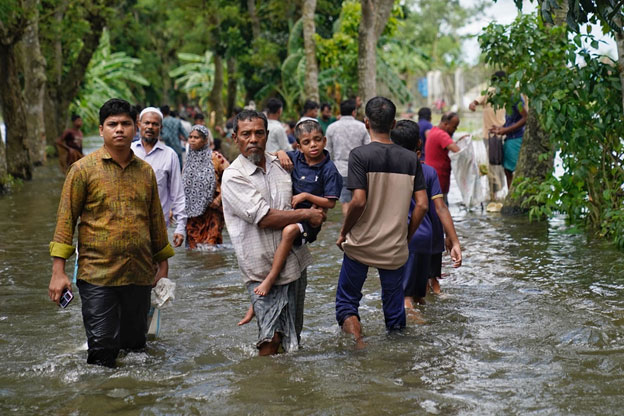
UNITED NATIONS, Sep 06 (IPS) – Since late August, extreme flash floods and monsoons plaguing Bangladesh have affected practically 6 million folks. Bangladeshi officers have declared the floods to be the nation’s worst local weather catastrophe in latest reminiscence. These latest floods observe the wake of Cyclone Remal, which devastated Bangladesh and West Bengal earlier this yr.
Floods have brought about widespread destruction in Bangladesh, with the Feni, Cumilla, Laxipur, Chattogram, and Noakhali districts amongst these hit hardest. The United Nations Kids’s Fund (UNICEF) has acknowledged that 71 folks have been reported useless. The floods have decimated villages, with hundreds of houses having been destroyed or submerged underwater, inflicting widespread inner displacement.
“Thus far, a reported 500,000 folks have been displaced in additional than 3,400 evacuation shelters”, Stéphane Dujarric, Spokesman for the UN Secretary-Normal, mentioned throughout a press briefing held on September 4 on the headquarters in New York.
“We, together with our humanitarian companions, are mobilized and supporting the government-led flood response,” Dujarric mentioned. “We’re additionally serving to with native efforts to assist essentially the most susceptible folks and communities impacted by these floods.”
Displacement shelters in Bangladesh have turn out to be overcrowded because of the sheer quantity of civilians that had been displaced from their communities. In response to an August 30 report from the United Nations Inter-Cluster Coordination Group (ICCG), this has heightened safety issues for affected girls and women.
Floods have additionally broken crucial infrastructure in Bangladesh, drastically impeding reduction efforts by humanitarian organizations. Farah Kabir, Nation Director of ActionAid Bangladesh acknowledged “The disruption of roads and communication has additional escalated their plight, making it tough for them to succeed in security and important sources. The UN reviews that sure areas are completely inaccessible to help staff because of the extent of the excessive water ranges.
In response to the ICCG report, in Noakhali, roughly 50 % of the flood-affected areas are thought-about “unreachable” by native authorities and assist personnel. The floods have additionally brought about vital energy outages, aggravating these challenges in accessibility.
This has taken a big toll on nationwide training. Floods have ravaged academic services throughout the nation and have made numerous roads and passages inaccessible, making education for youngsters extraordinarily tough. In response to Dujarric, over 7000 faculties at the moment are closed on account of flooding, which has impacted 1.7 million kids and younger folks.
Water sanitation techniques have been severely compromised with the swelling of soiled water filling the streets. With out entry to emergency medical provides, the chance of contracting waterborne ailments has risen considerably.
Kabir added, “The collapse of the sanitation system in lots of areas has heightened the general public well being disaster”.
Final week, In a single occasion final week, Bangladesh’s Directorate of Normal Well being Companies (Dte. GHS) reported that over a interval of 24 hours because the flooding started, 5000 folks had been hospitalized, reporting instances of diarrhea, pores and skin infections and snake bites. UNICEF is at present on the frontlines of this catastrophe, distributing 3.6 million water purification tablets to stop the unfold of sicknesses.
Moreover, the livelihoods of hundreds of thousands have been impacted by the floods. Agriculture, particularly, has been hit the toughest. In response to Bangladesh’s agriculture ministry, the floods have resulted in a lack of 282 million US {dollars} on account of crop harm, impacting over 1.3 million farmers. That is considerably detrimental because the agricultural sector employs roughly 42 % of Bangladesh’s workforce.
Dujarric added that the floods have brought about 156 million US {dollars} value of losses in livestock and fisheries. This has devastated Bangladesh’s financial system in addition to drastically exacerbated ranges of meals insecurity nationwide.
“With provides disrupted, hundreds of households are nonetheless stranded in shelters with none meals,” mentioned Simone Parchment, the World Meals Programme (WFP) Consultant in Bangladesh, in a press launch issued on August 30. “Our focus is on delivering emergency help to the individuals who have been displaced and lack the means to cook dinner for themselves.”
A whole bunch of hundreds of persons are dealing with dangers of hunger and malnutrition as assist staff scramble to distribute dry meals to shelters. WFP is at present within the strategy of delivering fortified biscuits to 60,000 households in areas which have been hit the toughest.
The UN’s Performing Reduction Emergency Coordinator, Joyce Msuya, has allotted 4 million {dollars} from the UN’s Central Emergency Response Fund (CERF). As well as, UNICEF is on the frontlines of this catastrophe, offering over 338,000 folks with live-saving provides. Nonetheless, present efforts will not be sufficient to mitigate this catastrophe. UNICEF has requested over 35 million {dollars} from donors so as to present all households affected with medical help.
It is usually crucial to deal with the local weather disaster, as Bangladesh is among the world’s most climate-sensitive nations. A 2015 report by the World Financial institution Institute acknowledged that roughly 3.5 million folks in Bangladesh are affected by annual river flooding, a difficulty that’s solely worsened by the local weather disaster.
Deputy Consultant of UNICEF Bangladesh Emma Brigham remarked that the devastation brought on by the floods within the jap areas of Bangladesh are “a tragic reminder of the relentless affect of maximum climate occasions and the local weather disaster”, notably for youngsters. “Far too many kids have misplaced family members, their houses, faculties, and now are utterly destitute,” she mentioned.
IPS UN Bureau Report
Observe @IPSNewsUNBureau
Observe IPS Information UN Bureau on Instagram
© Inter Press Service (2024) — All Rights ReservedAuthentic supply: Inter Press Service












